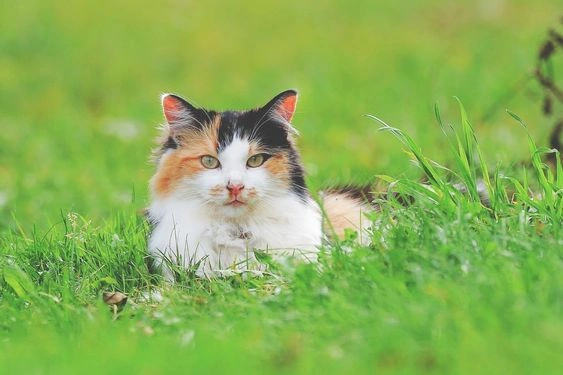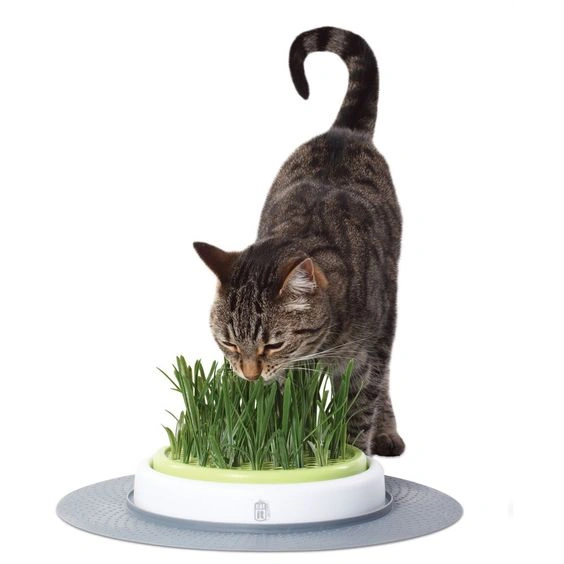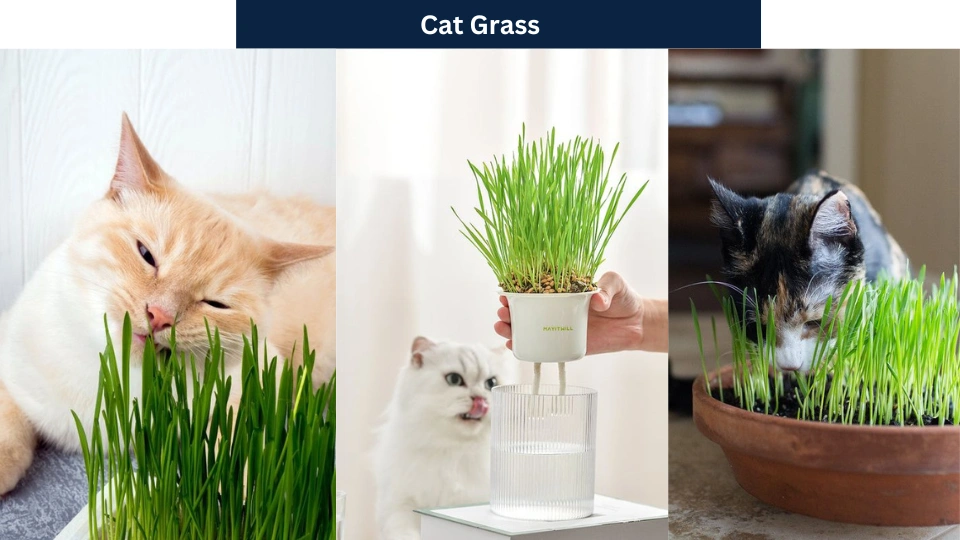Last Updated on March 11, 2024 by Aftab Tariq
Cat Grass is a special plant that your fur baby might enjoy adding to her diet. While cats are obligate carnivores, meaning they primarily eat meat, they sometimes like to nibble on vegetation like salad greens.

So, what exactly is Cat Grass, and is it safe for your cat to eat? It’s wise to consult your vet before introducing anything new to your cat’s diet, but let’s explore this interesting addition that many cats love.
“Cat Grass Nature’s little gift to our feline friends.”
What Is Cat Grass?
Cat grass isn’t a specific plant, but a mix of grass seeds like wheat, barley, oats, or rye. It’s grown indoors for household pets, not like the grass outdoors in your yard, which might have harmful pesticides.
Cat grass has another benefit! It can stop your cat from going near dangerous or delicate plants. Trupanion suggests it as a way to keep your pet safe. If your cat likes to mess with your houseplants, having cat grass can distract her.
If your kitty loves chewing on or tipping over your plants, a cat grass garden can stop her. It’s a tasty snack just for her, so she’ll leave the other plants alone.
Cat Grass seeds are increasingly in demand. You can purchase them at your local pet store, online, or even from your vet’s office. Alternatively, you can create your own DIY greens for your cat by purchasing wheat berry seeds from the store.
Plant the seeds in soil, place the container in a sunny spot at home, and remember to water them regularly, but not excessively.
Your seeds will begin to sprout within a few days and should be ready for your cat to enjoy in about two weeks. Your cat can nibble directly from the garden pot without needing to transfer the grass to a dish.
Is Cat Grass Safe?
Contrary to a long-standing cat myth, cats don’t solely consume grass when they’re ill. Cat grass serves not just as entertainment but also aids in your cat’s digestion.

It contains folic acid, akin to that found in human breakfast cereal containing similar grains, which aids the bloodstream.
Additionally, it acts as a laxative, facilitating the removal of hairballs or food remnants. Nonetheless, if your cat excessively consumes grass, it’s advisable to consult your vet to rule out any underlying medical concerns.
It’s also vital to maintain a separate area for your cat garden away from other houseplants. The American Society for the Prevention of Cruelty to Animals provides a comprehensive list of common household plants that may be harmful to cats and dogs.
Keep plants like philodendrons and aloe out of reach by placing them on high shelves or in hanging pots, and position your cat grass in a low area where your cat can easily access it.
Cat Grass Care
Essential Tips for Maintaining Healthy Cat Grass:
- Regularly trim it. Even though pets will munch on cat grass, it’s advisable to trim it back about an inch every other week to prevent the leaves from drooping.
- Replant frequently. Keep replanting cat grass seeds to foster healthy and new growth.
- Check for any signs of pests.
- Utilize mulch.
- Water sparingly to avoid overhydration.
How Much is Enough?
Dealing with hairballs is a common thing for cat owners, especially if your cat has long hair or sheds a lot. Cat grass can help with this, especially if your cat eats a lot at once. Animal Planet mentions that cats often vomit shortly after munching away on grass.
However, not every time your cat nibbles on grass will she throw up. If she does, or if you see grass in her vomit, it might mean something needs to be unclogged.
There isn’t a set amount of grass you should plant, but experts like the Burpee Seed Company suggest planting a handful of seeds at once. If you have more than one cat, it’s a good idea to give each cat their own patch of grass so they don’t have to share.
Is cat grass safe? Yes, especially if you buy the right kit or seeds and keep an eye on your cat’s habits and health. If anything seems out of the ordinary, contact your vet right away.
Not all cats will eat cat grass (they can be picky eaters), but many do. So why not offer some to your furry friend and see if she enjoys having her own little garden? She might really like it.
Key Point
- Cat grass is grown indoors specifically for household pets, unlike outdoor grass that may contain harmful pesticides.
- It serves as both a deterrent and a tasty alternative snack to keep cats away from other potentially harmful or delicate plants.
- Cat Grass benefits include aiding in the digestive system of cats, alongside providing them with pleasure.
Note: Enhance your cat’s indoor environment with a convenient Cat Grass kit, available on Amazon for easy access to this natural and nutritious treat.
If anyone wants to learn more about pets, they can read our articles at harpersatelier.
Frequently Asked Questions
What are Cat Grass Sticks?
Cat Grass sticks are special sticks or wands filled with cat grass seeds. You plant them in soil to grow fresh cat grass for your cat to enjoy.
What Can be Found under Cat Grass Bunnings?
Under Cat Grass Bunnings, you can typically find various products related to cat grass cultivation, including seeds, growing kits, or pre-grown cat grass pots, available at Bunnings stores.
Sources
I am a dedicated content writer with more than five years of experience, particularly skilled in the art of storytelling. My writing journey commenced during my college years, where I pursued journalism and unearthed my talent for creating captivating narratives.


